Extended Literature Review: Drug Errors by Nurses in Acute Settings
VerifiedAdded on 2021/04/24
|50
|11630
|78
Report
AI Summary
This extended literature review investigates the causes of drug administration errors by nurses in acute clinical settings. The study, based on a qualitative research approach and extensive literature review, identifies key factors such as lack of proper training and experience, poor communication skills, and high workload as significant contributors to drug errors. The report outlines the methodology, including the use of keywords, bibliographic aids, and inclusion/exclusion criteria to select relevant articles. The findings highlight the impact of these factors and propose recommendations for practice, including improved nurse education, comprehensive training programs, and the implementation of technological aids to mitigate the risk of medication errors. The research aims to provide insights for hospital managers and stakeholders to develop interventions for enhancing patient safety and improving the quality of healthcare services.
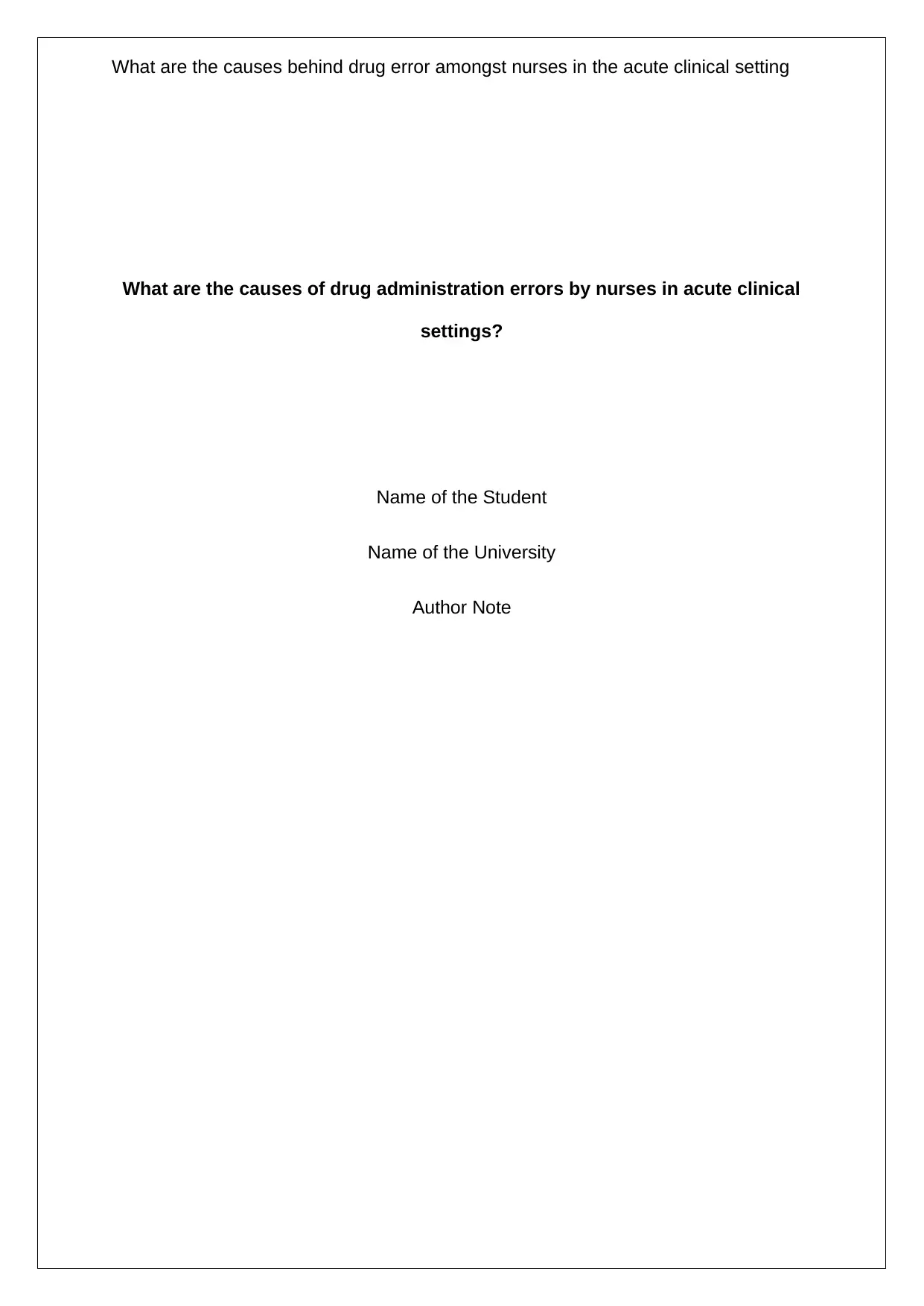
What are the causes behind drug error amongst nurses in the acute clinical setting
What are the causes of drug administration errors by nurses in acute clinical
settings?
Name of the Student
Name of the University
Author Note
What are the causes of drug administration errors by nurses in acute clinical
settings?
Name of the Student
Name of the University
Author Note
Paraphrase This Document
Need a fresh take? Get an instant paraphrase of this document with our AI Paraphraser
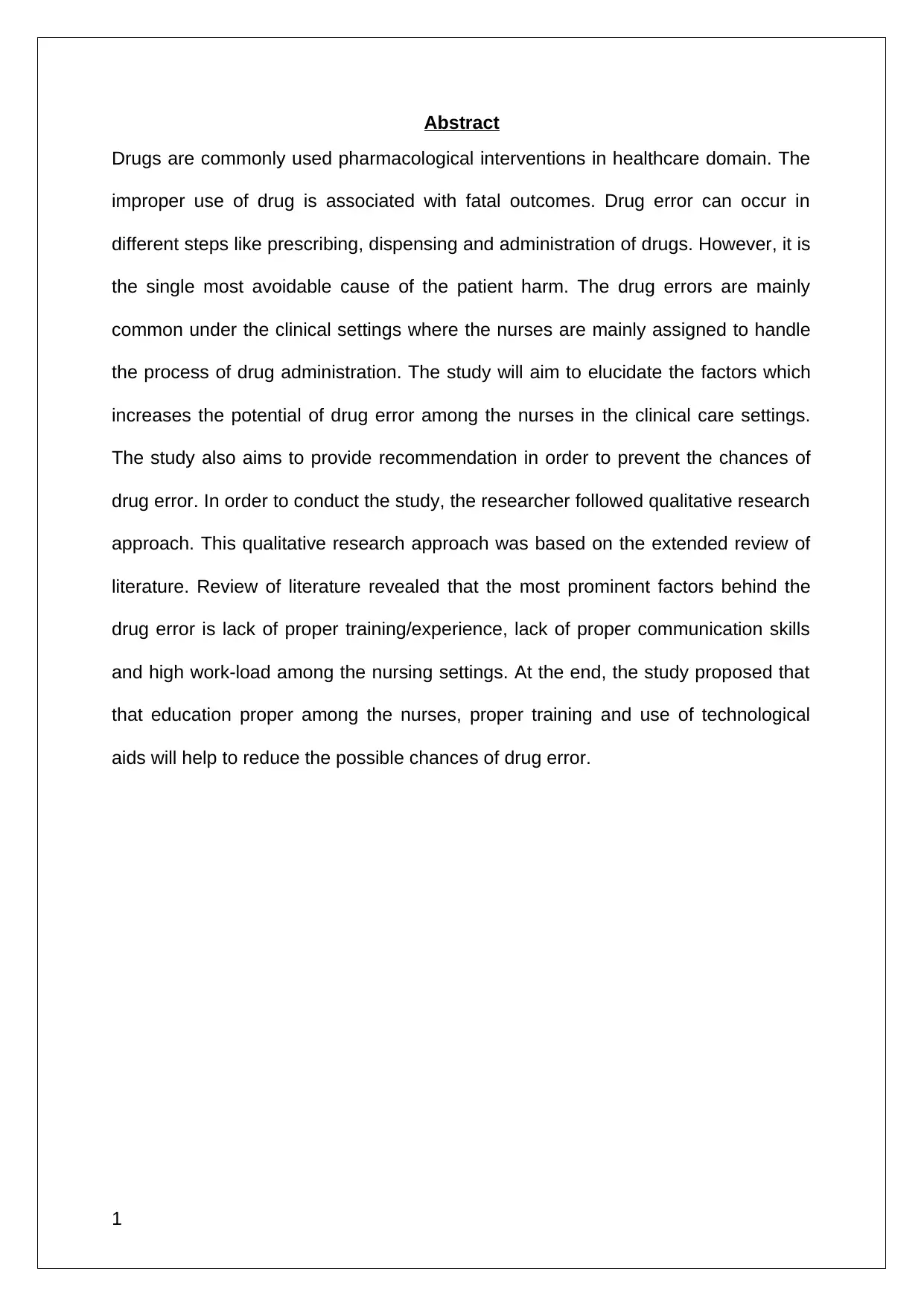
Abstract
Drugs are commonly used pharmacological interventions in healthcare domain. The
improper use of drug is associated with fatal outcomes. Drug error can occur in
different steps like prescribing, dispensing and administration of drugs. However, it is
the single most avoidable cause of the patient harm. The drug errors are mainly
common under the clinical settings where the nurses are mainly assigned to handle
the process of drug administration. The study will aim to elucidate the factors which
increases the potential of drug error among the nurses in the clinical care settings.
The study also aims to provide recommendation in order to prevent the chances of
drug error. In order to conduct the study, the researcher followed qualitative research
approach. This qualitative research approach was based on the extended review of
literature. Review of literature revealed that the most prominent factors behind the
drug error is lack of proper training/experience, lack of proper communication skills
and high work-load among the nursing settings. At the end, the study proposed that
that education proper among the nurses, proper training and use of technological
aids will help to reduce the possible chances of drug error.
1
Drugs are commonly used pharmacological interventions in healthcare domain. The
improper use of drug is associated with fatal outcomes. Drug error can occur in
different steps like prescribing, dispensing and administration of drugs. However, it is
the single most avoidable cause of the patient harm. The drug errors are mainly
common under the clinical settings where the nurses are mainly assigned to handle
the process of drug administration. The study will aim to elucidate the factors which
increases the potential of drug error among the nurses in the clinical care settings.
The study also aims to provide recommendation in order to prevent the chances of
drug error. In order to conduct the study, the researcher followed qualitative research
approach. This qualitative research approach was based on the extended review of
literature. Review of literature revealed that the most prominent factors behind the
drug error is lack of proper training/experience, lack of proper communication skills
and high work-load among the nursing settings. At the end, the study proposed that
that education proper among the nurses, proper training and use of technological
aids will help to reduce the possible chances of drug error.
1
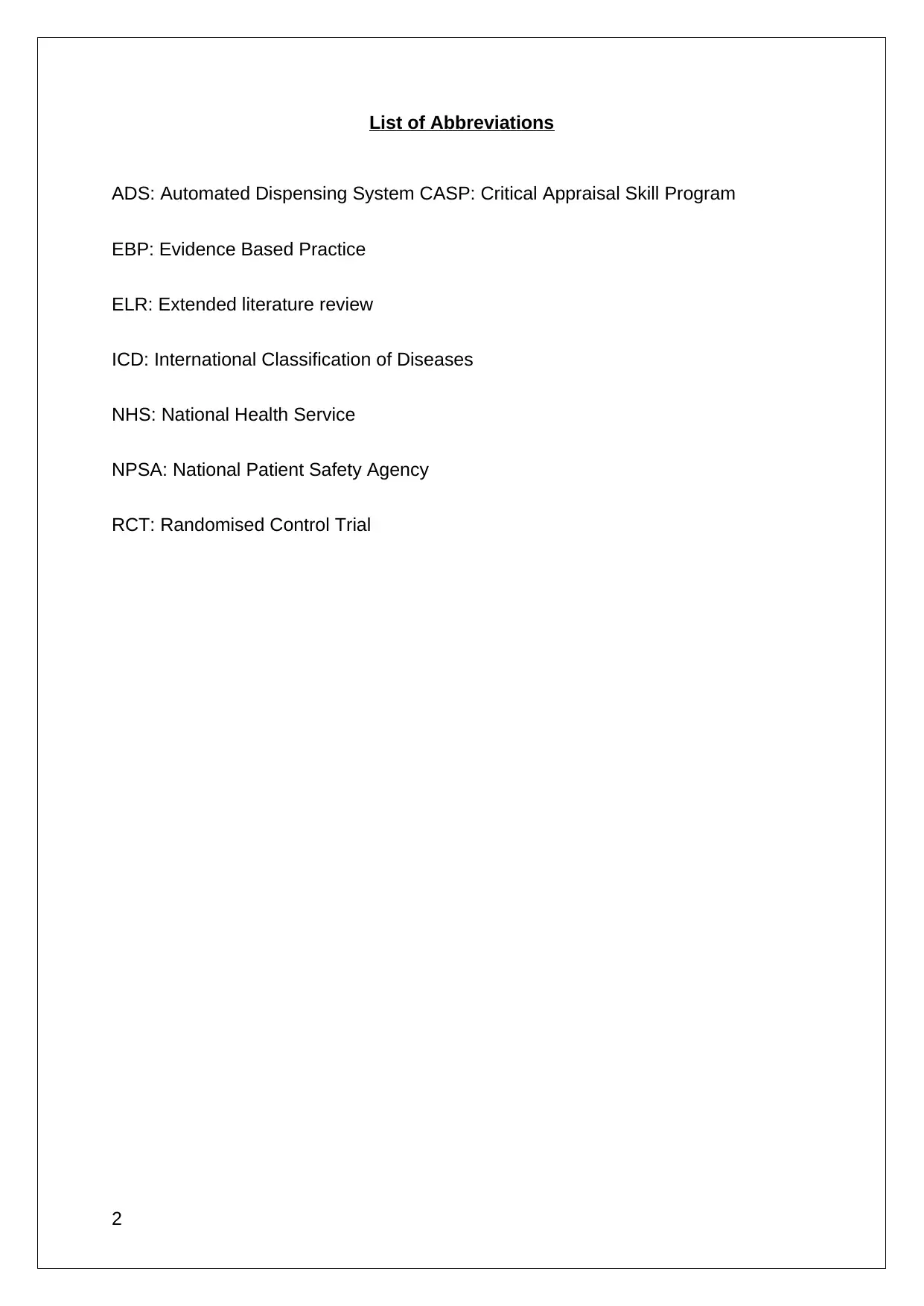
List of Abbreviations
ADS: Automated Dispensing System CASP: Critical Appraisal Skill Program
EBP: Evidence Based Practice
ELR: Extended literature review
ICD: International Classification of Diseases
NHS: National Health Service
NPSA: National Patient Safety Agency
RCT: Randomised Control Trial
2
ADS: Automated Dispensing System CASP: Critical Appraisal Skill Program
EBP: Evidence Based Practice
ELR: Extended literature review
ICD: International Classification of Diseases
NHS: National Health Service
NPSA: National Patient Safety Agency
RCT: Randomised Control Trial
2
⊘ This is a preview!⊘
Do you want full access?
Subscribe today to unlock all pages.

Trusted by 1+ million students worldwide
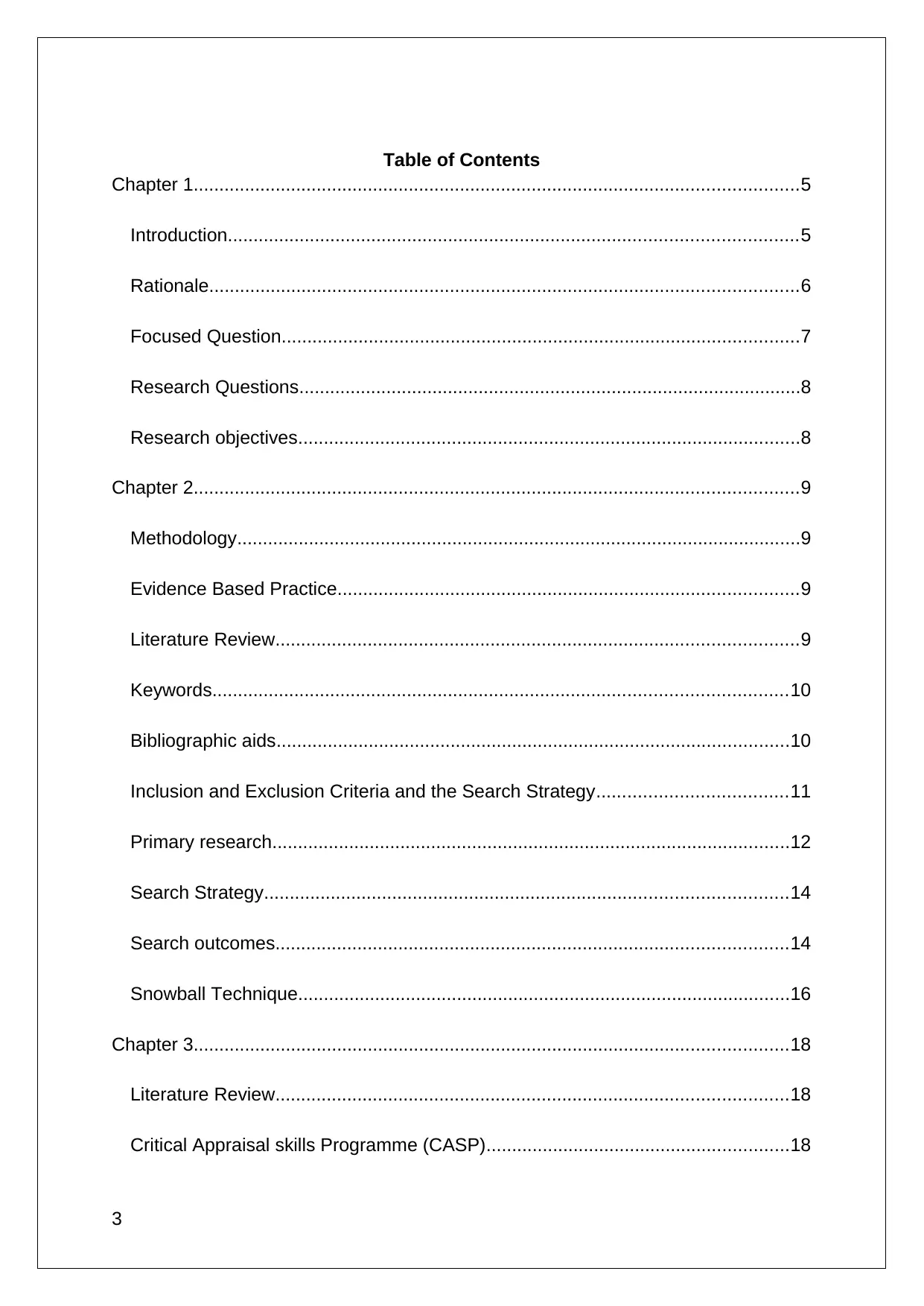
Table of Contents
Chapter 1......................................................................................................................5
Introduction...............................................................................................................5
Rationale...................................................................................................................6
Focused Question.....................................................................................................7
Research Questions..................................................................................................8
Research objectives..................................................................................................8
Chapter 2......................................................................................................................9
Methodology..............................................................................................................9
Evidence Based Practice..........................................................................................9
Literature Review......................................................................................................9
Keywords................................................................................................................10
Bibliographic aids....................................................................................................10
Inclusion and Exclusion Criteria and the Search Strategy.....................................11
Primary research.....................................................................................................12
Search Strategy......................................................................................................14
Search outcomes....................................................................................................14
Snowball Technique................................................................................................16
Chapter 3....................................................................................................................18
Literature Review....................................................................................................18
Critical Appraisal skills Programme (CASP)...........................................................18
3
Chapter 1......................................................................................................................5
Introduction...............................................................................................................5
Rationale...................................................................................................................6
Focused Question.....................................................................................................7
Research Questions..................................................................................................8
Research objectives..................................................................................................8
Chapter 2......................................................................................................................9
Methodology..............................................................................................................9
Evidence Based Practice..........................................................................................9
Literature Review......................................................................................................9
Keywords................................................................................................................10
Bibliographic aids....................................................................................................10
Inclusion and Exclusion Criteria and the Search Strategy.....................................11
Primary research.....................................................................................................12
Search Strategy......................................................................................................14
Search outcomes....................................................................................................14
Snowball Technique................................................................................................16
Chapter 3....................................................................................................................18
Literature Review....................................................................................................18
Critical Appraisal skills Programme (CASP)...........................................................18
3
Paraphrase This Document
Need a fresh take? Get an instant paraphrase of this document with our AI Paraphraser
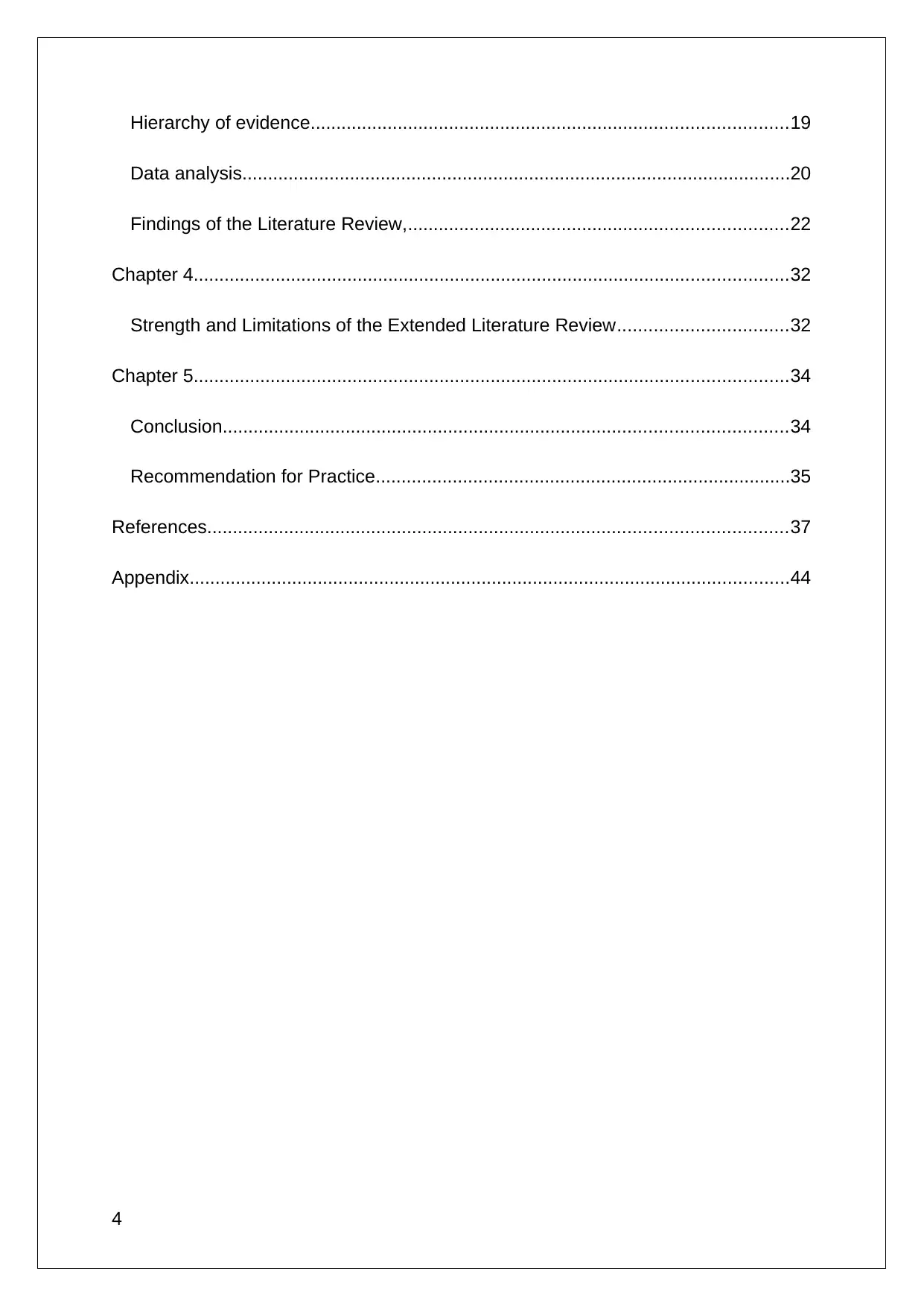
Hierarchy of evidence.............................................................................................19
Data analysis...........................................................................................................20
Findings of the Literature Review,..........................................................................22
Chapter 4....................................................................................................................32
Strength and Limitations of the Extended Literature Review.................................32
Chapter 5....................................................................................................................34
Conclusion..............................................................................................................34
Recommendation for Practice.................................................................................35
References.................................................................................................................37
Appendix.....................................................................................................................44
4
Data analysis...........................................................................................................20
Findings of the Literature Review,..........................................................................22
Chapter 4....................................................................................................................32
Strength and Limitations of the Extended Literature Review.................................32
Chapter 5....................................................................................................................34
Conclusion..............................................................................................................34
Recommendation for Practice.................................................................................35
References.................................................................................................................37
Appendix.....................................................................................................................44
4
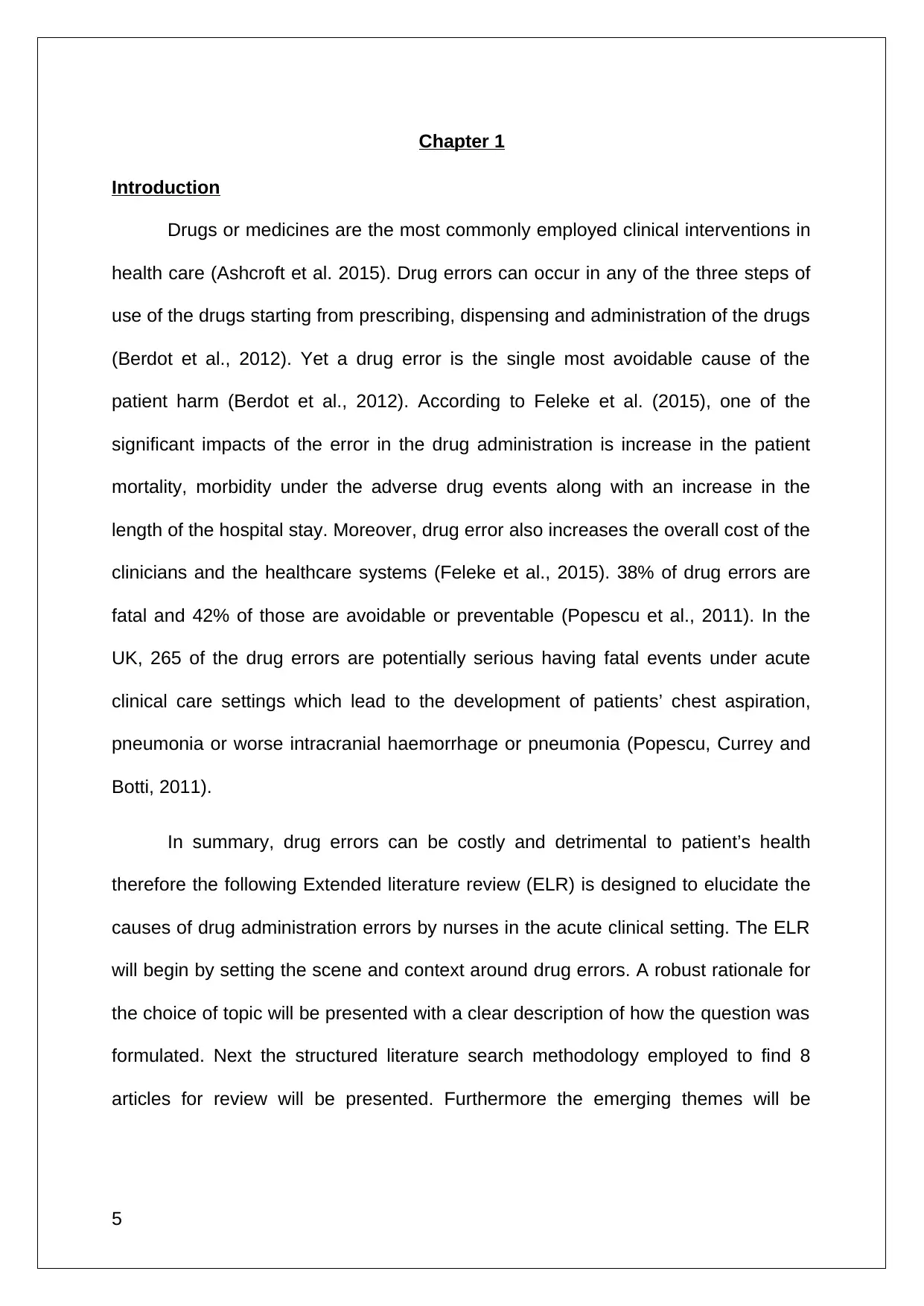
Chapter 1
Introduction
Drugs or medicines are the most commonly employed clinical interventions in
health care (Ashcroft et al. 2015). Drug errors can occur in any of the three steps of
use of the drugs starting from prescribing, dispensing and administration of the drugs
(Berdot et al., 2012). Yet a drug error is the single most avoidable cause of the
patient harm (Berdot et al., 2012). According to Feleke et al. (2015), one of the
significant impacts of the error in the drug administration is increase in the patient
mortality, morbidity under the adverse drug events along with an increase in the
length of the hospital stay. Moreover, drug error also increases the overall cost of the
clinicians and the healthcare systems (Feleke et al., 2015). 38% of drug errors are
fatal and 42% of those are avoidable or preventable (Popescu et al., 2011). In the
UK, 265 of the drug errors are potentially serious having fatal events under acute
clinical care settings which lead to the development of patients’ chest aspiration,
pneumonia or worse intracranial haemorrhage or pneumonia (Popescu, Currey and
Botti, 2011).
In summary, drug errors can be costly and detrimental to patient’s health
therefore the following Extended literature review (ELR) is designed to elucidate the
causes of drug administration errors by nurses in the acute clinical setting. The ELR
will begin by setting the scene and context around drug errors. A robust rationale for
the choice of topic will be presented with a clear description of how the question was
formulated. Next the structured literature search methodology employed to find 8
articles for review will be presented. Furthermore the emerging themes will be
5
Introduction
Drugs or medicines are the most commonly employed clinical interventions in
health care (Ashcroft et al. 2015). Drug errors can occur in any of the three steps of
use of the drugs starting from prescribing, dispensing and administration of the drugs
(Berdot et al., 2012). Yet a drug error is the single most avoidable cause of the
patient harm (Berdot et al., 2012). According to Feleke et al. (2015), one of the
significant impacts of the error in the drug administration is increase in the patient
mortality, morbidity under the adverse drug events along with an increase in the
length of the hospital stay. Moreover, drug error also increases the overall cost of the
clinicians and the healthcare systems (Feleke et al., 2015). 38% of drug errors are
fatal and 42% of those are avoidable or preventable (Popescu et al., 2011). In the
UK, 265 of the drug errors are potentially serious having fatal events under acute
clinical care settings which lead to the development of patients’ chest aspiration,
pneumonia or worse intracranial haemorrhage or pneumonia (Popescu, Currey and
Botti, 2011).
In summary, drug errors can be costly and detrimental to patient’s health
therefore the following Extended literature review (ELR) is designed to elucidate the
causes of drug administration errors by nurses in the acute clinical setting. The ELR
will begin by setting the scene and context around drug errors. A robust rationale for
the choice of topic will be presented with a clear description of how the question was
formulated. Next the structured literature search methodology employed to find 8
articles for review will be presented. Furthermore the emerging themes will be
5
⊘ This is a preview!⊘
Do you want full access?
Subscribe today to unlock all pages.

Trusted by 1+ million students worldwide
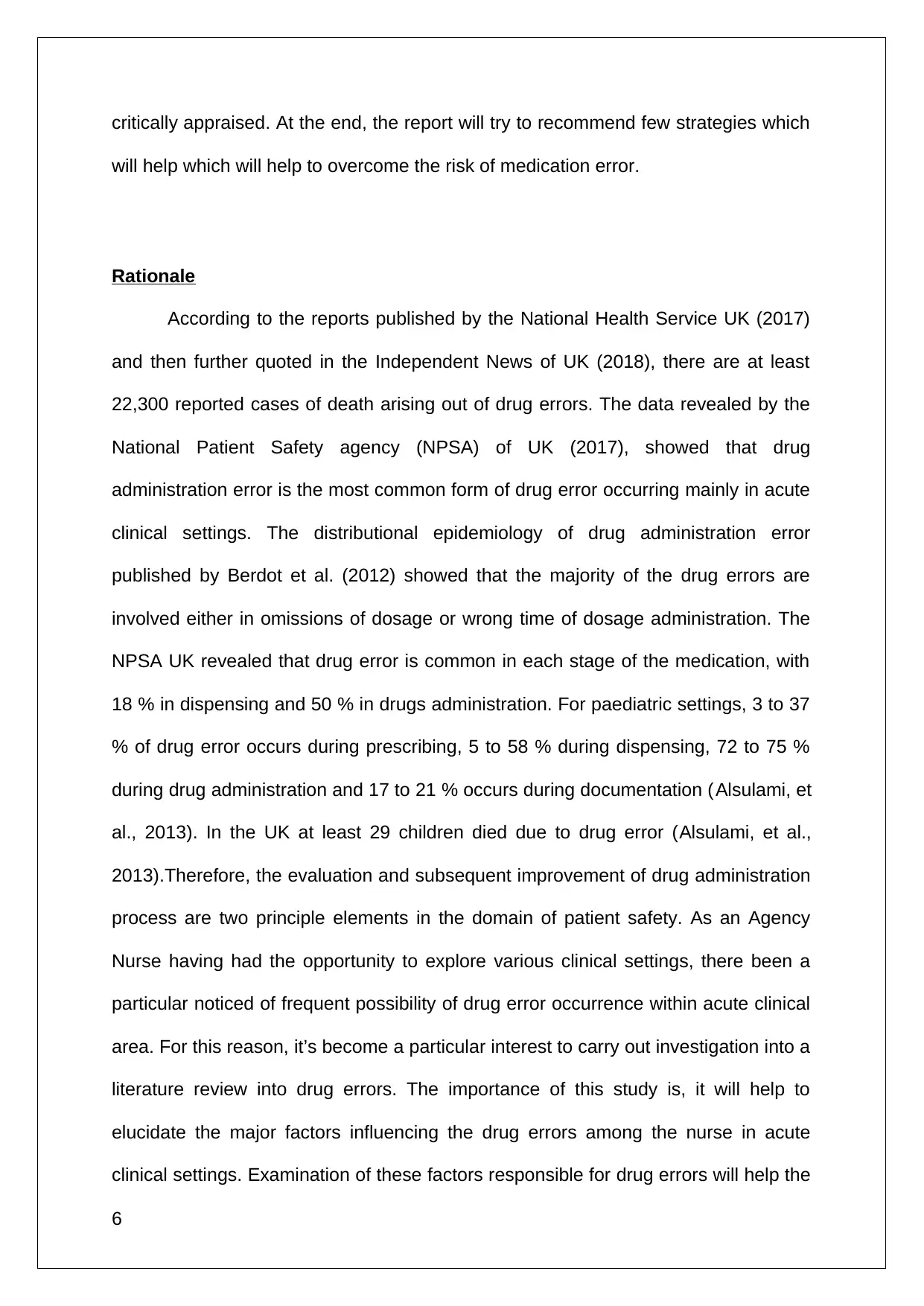
critically appraised. At the end, the report will try to recommend few strategies which
will help which will help to overcome the risk of medication error.
Rationale
According to the reports published by the National Health Service UK (2017)
and then further quoted in the Independent News of UK (2018), there are at least
22,300 reported cases of death arising out of drug errors. The data revealed by the
National Patient Safety agency (NPSA) of UK (2017), showed that drug
administration error is the most common form of drug error occurring mainly in acute
clinical settings. The distributional epidemiology of drug administration error
published by Berdot et al. (2012) showed that the majority of the drug errors are
involved either in omissions of dosage or wrong time of dosage administration. The
NPSA UK revealed that drug error is common in each stage of the medication, with
18 % in dispensing and 50 % in drugs administration. For paediatric settings, 3 to 37
% of drug error occurs during prescribing, 5 to 58 % during dispensing, 72 to 75 %
during drug administration and 17 to 21 % occurs during documentation (Alsulami, et
al., 2013). In the UK at least 29 children died due to drug error (Alsulami, et al.,
2013).Therefore, the evaluation and subsequent improvement of drug administration
process are two principle elements in the domain of patient safety. As an Agency
Nurse having had the opportunity to explore various clinical settings, there been a
particular noticed of frequent possibility of drug error occurrence within acute clinical
area. For this reason, it’s become a particular interest to carry out investigation into a
literature review into drug errors. The importance of this study is, it will help to
elucidate the major factors influencing the drug errors among the nurse in acute
clinical settings. Examination of these factors responsible for drug errors will help the
6
will help which will help to overcome the risk of medication error.
Rationale
According to the reports published by the National Health Service UK (2017)
and then further quoted in the Independent News of UK (2018), there are at least
22,300 reported cases of death arising out of drug errors. The data revealed by the
National Patient Safety agency (NPSA) of UK (2017), showed that drug
administration error is the most common form of drug error occurring mainly in acute
clinical settings. The distributional epidemiology of drug administration error
published by Berdot et al. (2012) showed that the majority of the drug errors are
involved either in omissions of dosage or wrong time of dosage administration. The
NPSA UK revealed that drug error is common in each stage of the medication, with
18 % in dispensing and 50 % in drugs administration. For paediatric settings, 3 to 37
% of drug error occurs during prescribing, 5 to 58 % during dispensing, 72 to 75 %
during drug administration and 17 to 21 % occurs during documentation (Alsulami, et
al., 2013). In the UK at least 29 children died due to drug error (Alsulami, et al.,
2013).Therefore, the evaluation and subsequent improvement of drug administration
process are two principle elements in the domain of patient safety. As an Agency
Nurse having had the opportunity to explore various clinical settings, there been a
particular noticed of frequent possibility of drug error occurrence within acute clinical
area. For this reason, it’s become a particular interest to carry out investigation into a
literature review into drug errors. The importance of this study is, it will help to
elucidate the major factors influencing the drug errors among the nurse in acute
clinical settings. Examination of these factors responsible for drug errors will help the
6
Paraphrase This Document
Need a fresh take? Get an instant paraphrase of this document with our AI Paraphraser
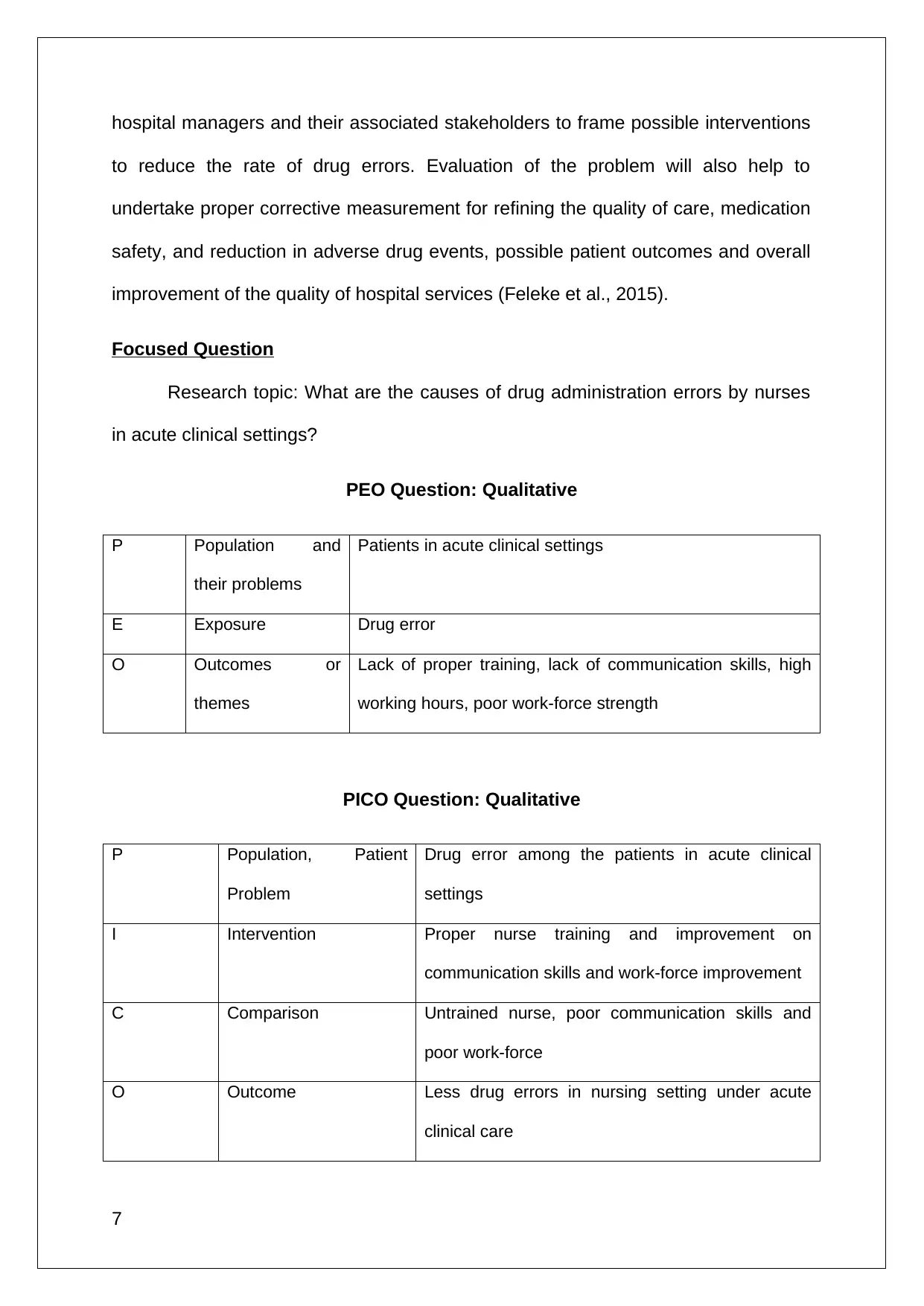
hospital managers and their associated stakeholders to frame possible interventions
to reduce the rate of drug errors. Evaluation of the problem will also help to
undertake proper corrective measurement for refining the quality of care, medication
safety, and reduction in adverse drug events, possible patient outcomes and overall
improvement of the quality of hospital services (Feleke et al., 2015).
Focused Question
Research topic: What are the causes of drug administration errors by nurses
in acute clinical settings?
PEO Question: Qualitative
P Population and
their problems
Patients in acute clinical settings
E Exposure Drug error
O Outcomes or
themes
Lack of proper training, lack of communication skills, high
working hours, poor work-force strength
PICO Question: Qualitative
P Population, Patient
Problem
Drug error among the patients in acute clinical
settings
I Intervention Proper nurse training and improvement on
communication skills and work-force improvement
C Comparison Untrained nurse, poor communication skills and
poor work-force
O Outcome Less drug errors in nursing setting under acute
clinical care
7
to reduce the rate of drug errors. Evaluation of the problem will also help to
undertake proper corrective measurement for refining the quality of care, medication
safety, and reduction in adverse drug events, possible patient outcomes and overall
improvement of the quality of hospital services (Feleke et al., 2015).
Focused Question
Research topic: What are the causes of drug administration errors by nurses
in acute clinical settings?
PEO Question: Qualitative
P Population and
their problems
Patients in acute clinical settings
E Exposure Drug error
O Outcomes or
themes
Lack of proper training, lack of communication skills, high
working hours, poor work-force strength
PICO Question: Qualitative
P Population, Patient
Problem
Drug error among the patients in acute clinical
settings
I Intervention Proper nurse training and improvement on
communication skills and work-force improvement
C Comparison Untrained nurse, poor communication skills and
poor work-force
O Outcome Less drug errors in nursing setting under acute
clinical care
7
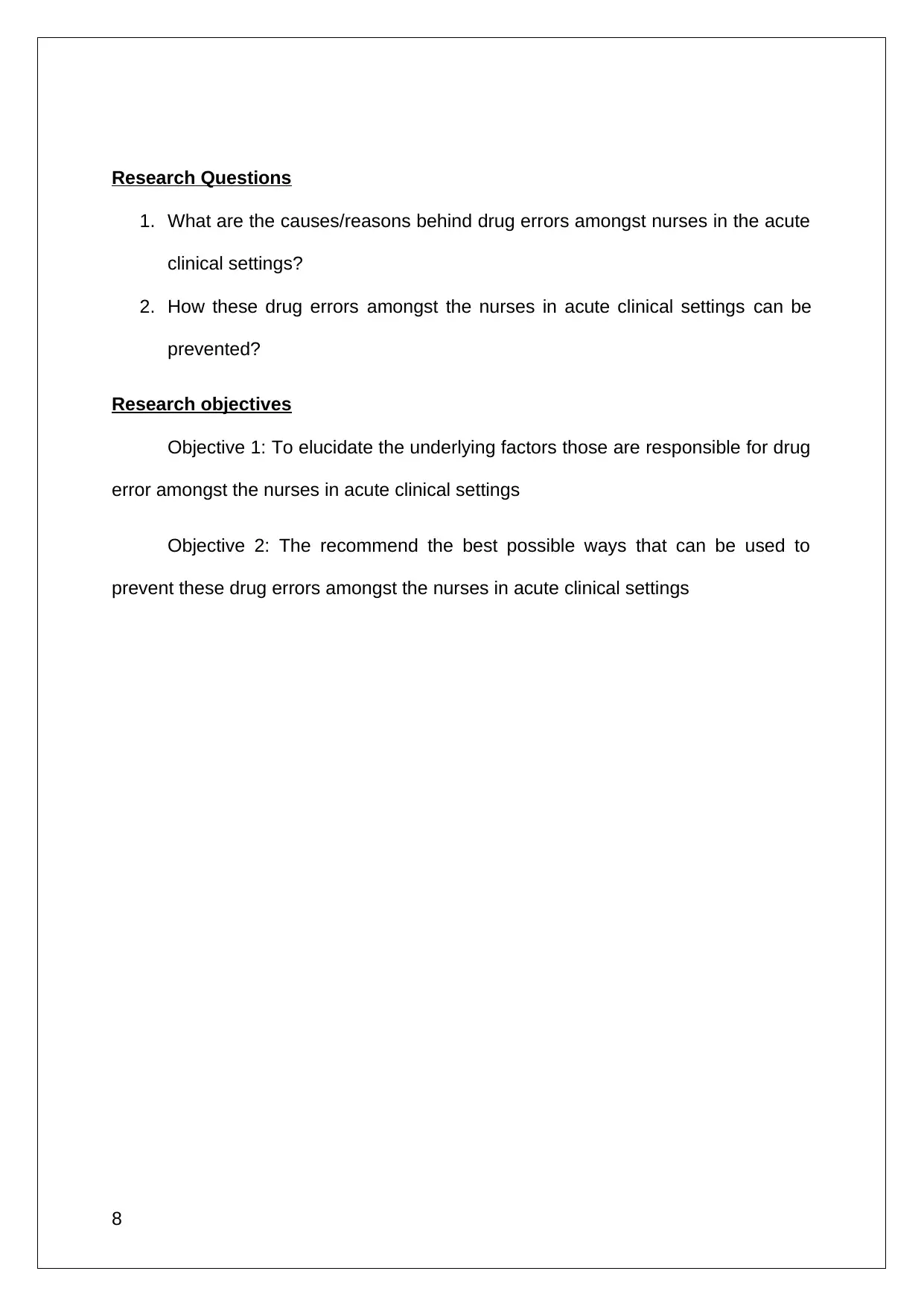
Research Questions
1. What are the causes/reasons behind drug errors amongst nurses in the acute
clinical settings?
2. How these drug errors amongst the nurses in acute clinical settings can be
prevented?
Research objectives
Objective 1: To elucidate the underlying factors those are responsible for drug
error amongst the nurses in acute clinical settings
Objective 2: The recommend the best possible ways that can be used to
prevent these drug errors amongst the nurses in acute clinical settings
8
1. What are the causes/reasons behind drug errors amongst nurses in the acute
clinical settings?
2. How these drug errors amongst the nurses in acute clinical settings can be
prevented?
Research objectives
Objective 1: To elucidate the underlying factors those are responsible for drug
error amongst the nurses in acute clinical settings
Objective 2: The recommend the best possible ways that can be used to
prevent these drug errors amongst the nurses in acute clinical settings
8
⊘ This is a preview!⊘
Do you want full access?
Subscribe today to unlock all pages.

Trusted by 1+ million students worldwide
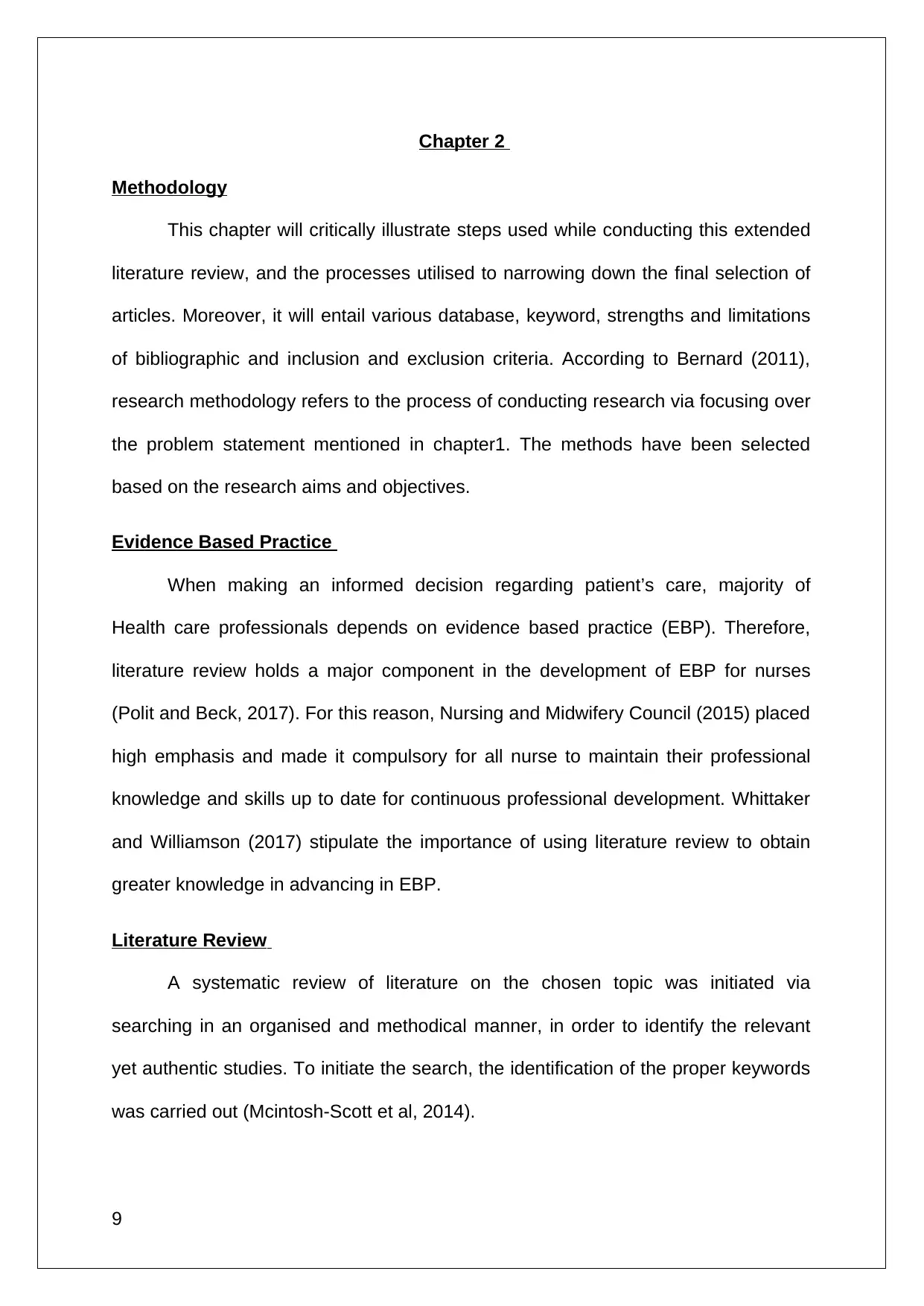
Chapter 2
Methodology
This chapter will critically illustrate steps used while conducting this extended
literature review, and the processes utilised to narrowing down the final selection of
articles. Moreover, it will entail various database, keyword, strengths and limitations
of bibliographic and inclusion and exclusion criteria. According to Bernard (2011),
research methodology refers to the process of conducting research via focusing over
the problem statement mentioned in chapter1. The methods have been selected
based on the research aims and objectives.
Evidence Based Practice
When making an informed decision regarding patient’s care, majority of
Health care professionals depends on evidence based practice (EBP). Therefore,
literature review holds a major component in the development of EBP for nurses
(Polit and Beck, 2017). For this reason, Nursing and Midwifery Council (2015) placed
high emphasis and made it compulsory for all nurse to maintain their professional
knowledge and skills up to date for continuous professional development. Whittaker
and Williamson (2017) stipulate the importance of using literature review to obtain
greater knowledge in advancing in EBP.
Literature Review
A systematic review of literature on the chosen topic was initiated via
searching in an organised and methodical manner, in order to identify the relevant
yet authentic studies. To initiate the search, the identification of the proper keywords
was carried out (Mcintosh-Scott et al, 2014).
9
Methodology
This chapter will critically illustrate steps used while conducting this extended
literature review, and the processes utilised to narrowing down the final selection of
articles. Moreover, it will entail various database, keyword, strengths and limitations
of bibliographic and inclusion and exclusion criteria. According to Bernard (2011),
research methodology refers to the process of conducting research via focusing over
the problem statement mentioned in chapter1. The methods have been selected
based on the research aims and objectives.
Evidence Based Practice
When making an informed decision regarding patient’s care, majority of
Health care professionals depends on evidence based practice (EBP). Therefore,
literature review holds a major component in the development of EBP for nurses
(Polit and Beck, 2017). For this reason, Nursing and Midwifery Council (2015) placed
high emphasis and made it compulsory for all nurse to maintain their professional
knowledge and skills up to date for continuous professional development. Whittaker
and Williamson (2017) stipulate the importance of using literature review to obtain
greater knowledge in advancing in EBP.
Literature Review
A systematic review of literature on the chosen topic was initiated via
searching in an organised and methodical manner, in order to identify the relevant
yet authentic studies. To initiate the search, the identification of the proper keywords
was carried out (Mcintosh-Scott et al, 2014).
9
Paraphrase This Document
Need a fresh take? Get an instant paraphrase of this document with our AI Paraphraser
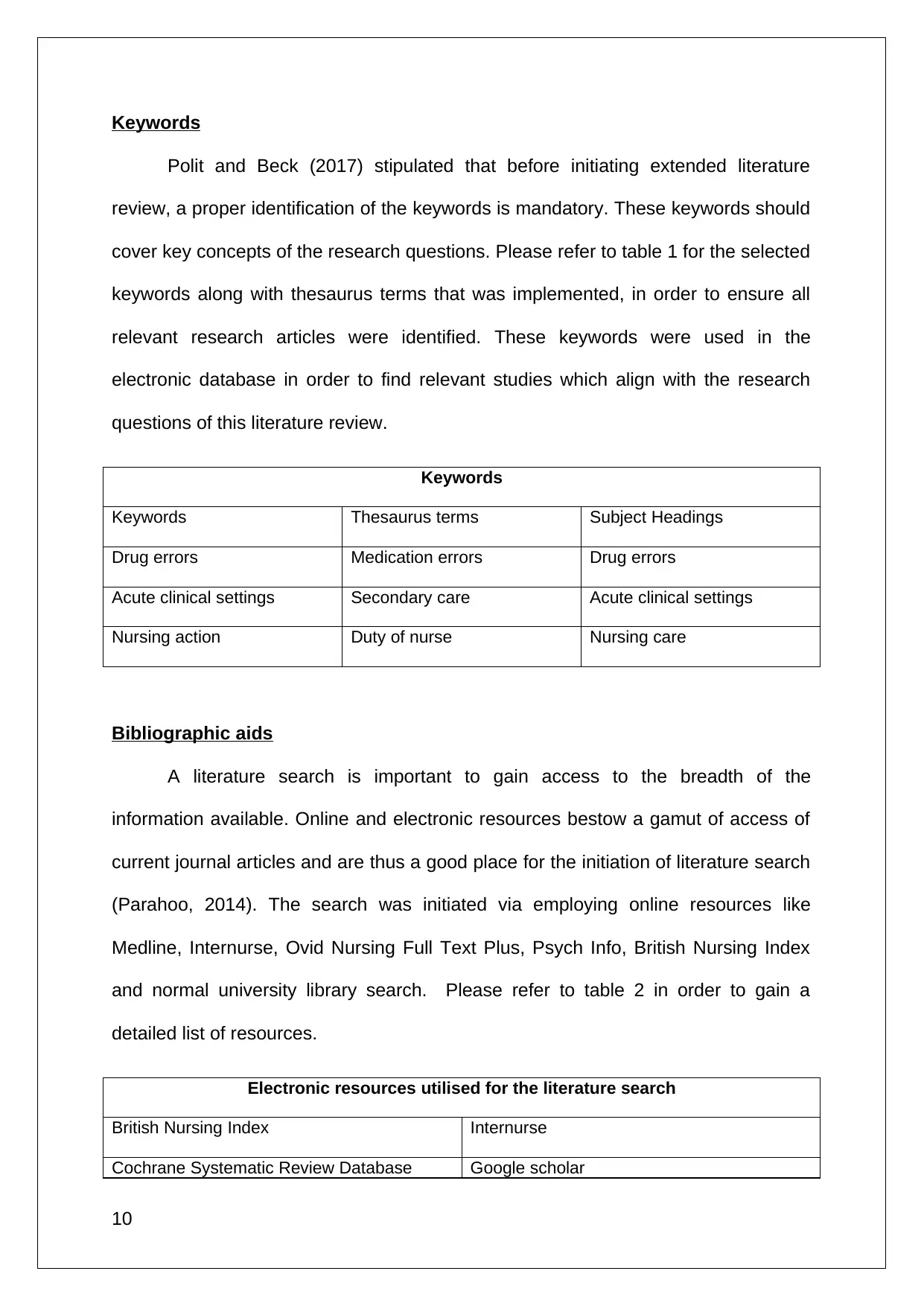
Keywords
Polit and Beck (2017) stipulated that before initiating extended literature
review, a proper identification of the keywords is mandatory. These keywords should
cover key concepts of the research questions. Please refer to table 1 for the selected
keywords along with thesaurus terms that was implemented, in order to ensure all
relevant research articles were identified. These keywords were used in the
electronic database in order to find relevant studies which align with the research
questions of this literature review.
Keywords
Keywords Thesaurus terms Subject Headings
Drug errors Medication errors Drug errors
Acute clinical settings Secondary care Acute clinical settings
Nursing action Duty of nurse Nursing care
Bibliographic aids
A literature search is important to gain access to the breadth of the
information available. Online and electronic resources bestow a gamut of access of
current journal articles and are thus a good place for the initiation of literature search
(Parahoo, 2014). The search was initiated via employing online resources like
Medline, Internurse, Ovid Nursing Full Text Plus, Psych Info, British Nursing Index
and normal university library search. Please refer to table 2 in order to gain a
detailed list of resources.
Electronic resources utilised for the literature search
British Nursing Index Internurse
Cochrane Systematic Review Database Google scholar
10
Polit and Beck (2017) stipulated that before initiating extended literature
review, a proper identification of the keywords is mandatory. These keywords should
cover key concepts of the research questions. Please refer to table 1 for the selected
keywords along with thesaurus terms that was implemented, in order to ensure all
relevant research articles were identified. These keywords were used in the
electronic database in order to find relevant studies which align with the research
questions of this literature review.
Keywords
Keywords Thesaurus terms Subject Headings
Drug errors Medication errors Drug errors
Acute clinical settings Secondary care Acute clinical settings
Nursing action Duty of nurse Nursing care
Bibliographic aids
A literature search is important to gain access to the breadth of the
information available. Online and electronic resources bestow a gamut of access of
current journal articles and are thus a good place for the initiation of literature search
(Parahoo, 2014). The search was initiated via employing online resources like
Medline, Internurse, Ovid Nursing Full Text Plus, Psych Info, British Nursing Index
and normal university library search. Please refer to table 2 in order to gain a
detailed list of resources.
Electronic resources utilised for the literature search
British Nursing Index Internurse
Cochrane Systematic Review Database Google scholar
10
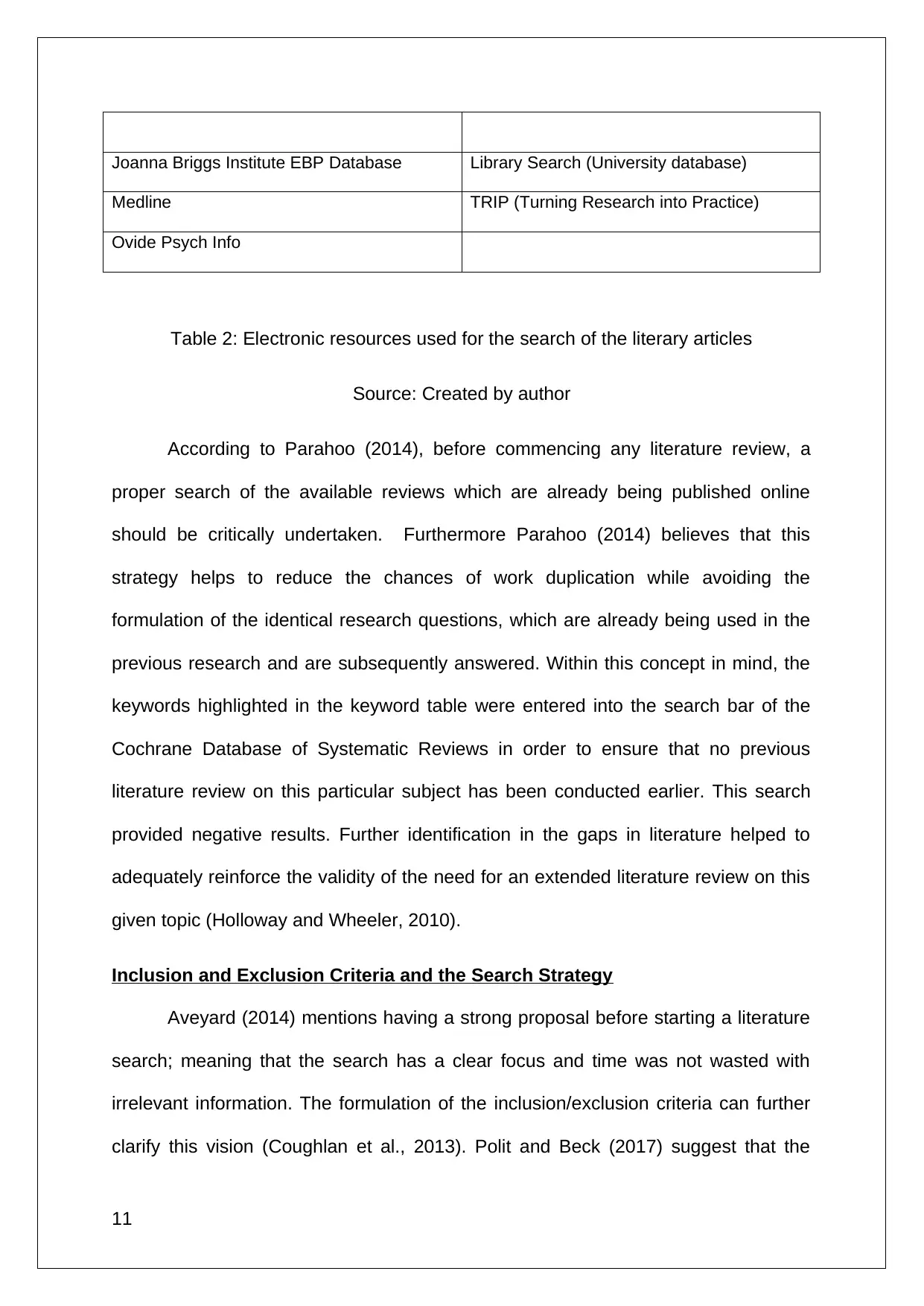
Joanna Briggs Institute EBP Database Library Search (University database)
Medline TRIP (Turning Research into Practice)
Ovide Psych Info
Table 2: Electronic resources used for the search of the literary articles
Source: Created by author
According to Parahoo (2014), before commencing any literature review, a
proper search of the available reviews which are already being published online
should be critically undertaken. Furthermore Parahoo (2014) believes that this
strategy helps to reduce the chances of work duplication while avoiding the
formulation of the identical research questions, which are already being used in the
previous research and are subsequently answered. Within this concept in mind, the
keywords highlighted in the keyword table were entered into the search bar of the
Cochrane Database of Systematic Reviews in order to ensure that no previous
literature review on this particular subject has been conducted earlier. This search
provided negative results. Further identification in the gaps in literature helped to
adequately reinforce the validity of the need for an extended literature review on this
given topic (Holloway and Wheeler, 2010).
Inclusion and Exclusion Criteria and the Search Strategy
Aveyard (2014) mentions having a strong proposal before starting a literature
search; meaning that the search has a clear focus and time was not wasted with
irrelevant information. The formulation of the inclusion/exclusion criteria can further
clarify this vision (Coughlan et al., 2013). Polit and Beck (2017) suggest that the
11
Medline TRIP (Turning Research into Practice)
Ovide Psych Info
Table 2: Electronic resources used for the search of the literary articles
Source: Created by author
According to Parahoo (2014), before commencing any literature review, a
proper search of the available reviews which are already being published online
should be critically undertaken. Furthermore Parahoo (2014) believes that this
strategy helps to reduce the chances of work duplication while avoiding the
formulation of the identical research questions, which are already being used in the
previous research and are subsequently answered. Within this concept in mind, the
keywords highlighted in the keyword table were entered into the search bar of the
Cochrane Database of Systematic Reviews in order to ensure that no previous
literature review on this particular subject has been conducted earlier. This search
provided negative results. Further identification in the gaps in literature helped to
adequately reinforce the validity of the need for an extended literature review on this
given topic (Holloway and Wheeler, 2010).
Inclusion and Exclusion Criteria and the Search Strategy
Aveyard (2014) mentions having a strong proposal before starting a literature
search; meaning that the search has a clear focus and time was not wasted with
irrelevant information. The formulation of the inclusion/exclusion criteria can further
clarify this vision (Coughlan et al., 2013). Polit and Beck (2017) suggest that the
11
⊘ This is a preview!⊘
Do you want full access?
Subscribe today to unlock all pages.

Trusted by 1+ million students worldwide
1 out of 50
Related Documents
Your All-in-One AI-Powered Toolkit for Academic Success.
+13062052269
info@desklib.com
Available 24*7 on WhatsApp / Email
![[object Object]](/_next/static/media/star-bottom.7253800d.svg)
Unlock your academic potential
Copyright © 2020–2025 A2Z Services. All Rights Reserved. Developed and managed by ZUCOL.





